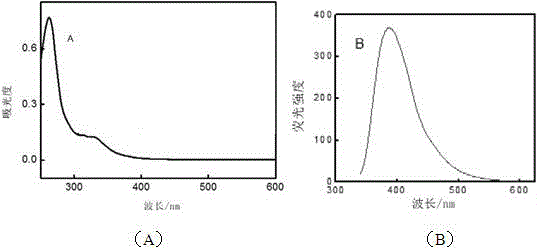Fluorescence biosensor for vascular endothelial growth factor detection in breast cancer
A biosensor and vascular endothelial technology, applied in the field of sensors, can solve the problems of high cost and cumbersome operation, and achieve the effect of strong ability, high sensitivity and huge application prospects
- Summary
- Abstract
- Description
- Claims
- Application Information
AI Technical Summary
Problems solved by technology
Method used
Image
Examples
Embodiment 1
[0023] The preparation method of fluorescent biosensor is as follows:
[0024] 1) Preparation of carbonized nitrogen nanomaterials: 2 mL of formamide was placed in a microwave tube, reacted at 170 °C for 30 min, washed 3 times with double distilled water, dried in vacuum for 8 h, dissolved in deionized water, and ultrasonically stripped for 24 h; The obtained liquid was centrifuged at 15000 r / min for 1 h, and the supernatant was obtained to obtain the suspension of carbonized nitrogen nanosheets; its spectrum was as follows: figure 1 and figure 2 shown;
[0025] 2) Preparation of 3-morpholine propanesulfonic acid (MOPS) buffer solution: weigh 0.5232 g of MOPS and 2.1248 g of NaNO 3 , after dissolving with double distilled water, transfer to 250 mL capacity, and constant volume, that is, 10 mmol / L MOPS solution; use 0.1 mol / L NaOH solution to adjust the pH to 7.0;
[0026] 3) Probe gene: 5'-CCCCCCTGTGGGGGTGGACGGGCCGGGTAGACCCCCC-3' (synthesized by Shanghai Sangon Bioenginee...
Embodiment 2
[0030] The fluorescence sensor of the present invention is used to detect VEGF, and the specific detection method is: adding a certain concentration of VEGF solution into the mixed system containing probe genes, silver ions and carbonized nitrogen nanosheets, and mixing and reacting. The above reaction solution was detected by fluorescence analysis.
[0031] The present invention uses the fluorescence analysis method detection technology of prior art to observe the fluorescence signal change of carbonized nitrogen nanomaterial; Experimental result sees attached Figure 4, it can be seen from the figure that within a certain range, as the concentration of the target protein increases (from 10 pmol / L to 70 pmol / L), the probe gene of the hairpin structure combines with the protein to form a G-quadruplex structure and opens and releases The more silver ions are released, the stronger the fluorescence degree of quenched carbonized nitrogen, and the weaker the fluorescence signal; t...
PUM
 Login to View More
Login to View More Abstract
Description
Claims
Application Information
 Login to View More
Login to View More - R&D
- Intellectual Property
- Life Sciences
- Materials
- Tech Scout
- Unparalleled Data Quality
- Higher Quality Content
- 60% Fewer Hallucinations
Browse by: Latest US Patents, China's latest patents, Technical Efficacy Thesaurus, Application Domain, Technology Topic, Popular Technical Reports.
© 2025 PatSnap. All rights reserved.Legal|Privacy policy|Modern Slavery Act Transparency Statement|Sitemap|About US| Contact US: help@patsnap.com



